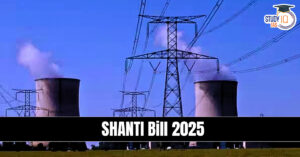Table of Contents
What is the EU’s Carbon Border Adjustment Mechanism (CBAM)?
- Purpose of CBAM: The Carbon Border Adjustment Mechanism (CBAM) is designed to impose a fair price on carbon emissions associated with the production of carbon-intensive goods entering the EU.
- It aims to promote cleaner industrial practices in non-EU countries.
- Carbon Pricing: CBAM ensures that the carbon price applied to imports is equivalent to the carbon price imposed on goods produced within the EU, thereby maintaining fair competition.
- Functioning Framework:
- Registration and Certification: EU importers of CBAM-covered goods must register with national authorities and acquire CBAM certificates that reflect the carbon emissions embedded in their imports.
- Annual Declaration: Importers are required to declare the emissions associated with their imported goods and surrender the corresponding number of certificates each year.
- Payment of Carbon Price: Importers must demonstrate that a carbon price has already been paid during the production of goods in a non-EU country to receive a deduction from their CBAM payment.
- Goods Covered by CBAM: Initially, CBAM targets high-risk carbon leakage goods, including:
- Cement
- Iron and steel
- Aluminium
- Fertilisers
- Electricity
- Hydrogen
- Over time, CBAM is expected to encompass more than 50% of emissions from sectors included in the EU Emissions Trading System (ETS), such as oil refineries and shipping.
- Impact on Indian Exports: The EU accounts for approximately 20.33% of India’s total merchandise exports, with 25.7% of these exports affected by CBAM.
- In the last five fiscal years, iron and steel have constituted 76.83% of these exports, followed by aluminium, cement, and fertilisers.
India’s Criticism
- Arbitrary Nature: India’s Finance Minister Nirmala Sitharaman described CBAM as “unilateral and arbitrary,” arguing that it imposes unfair burdens on developing countries that are still industrialising.
- Discriminatory Tool: India asserts that CBAM functions as a non-tariff barrier that undermines existing trade agreements and disproportionately impacts developing economies.
- The mechanism could lead to tariffs ranging from 20% to 35% on carbon-intensive goods such as steel and aluminium.
Economic Implications
- Trade Competitiveness: The imposition of CBAM could significantly increase costs for Indian exporters, making their products less competitive in the EU market.
- g., iron and steel exports to the EU are vital for India’s economy, and any additional tariffs could reduce demand.
- Potential Revenue for the EU: The revenues generated from CBAM are expected to fund the EU’s climate initiatives, estimated to be between €5 billion to €14 billion annually by 2030.
- India questions the fairness of this revenue not being shared with non-EU trading partners.
Proposed Indian Arguments at COP29
- Preparation Time:
- The EU achieved its targets gradually:
- 2020: 20% GHG emissions reduction compared to 1990 levels (EU Climate Action and Renewable Energy Package, 2008).
- 2019: Extended target to 55% below 1990 levels under the European Green Deal and Fit for 55 Package.
- India could question whether CBAM allows developing countries comparable adaptation time.
- The EU achieved its targets gradually:
- Revenue Sharing:
- Estimated Revenue: CBAM is expected to generate €5–14 billion annually by 2030.
- Use of Funds: Revenues will fund the NextGenerationEU recovery tool and operate CBAM.
- Indian Argument: Advocate for sharing CBAM revenues with non-EU trading partners to:
- Build capacity.
- Facilitate technology transfer in developing nations.
- Alternative Framework: Equity-Based Accounting (EBA):
- Principles: Advocates a shared obligation for emission reductions among trade partners, emphasising:
- Horizontal intra-generational equity: Fair distribution within the current generation.
- Vertical inter-generational equity: Fairness to future generations.
- Principles: Advocates a shared obligation for emission reductions among trade partners, emphasising:
- Proposal:
- Develop a tariff formula for EU imports considering:
- Per capita GDP.
- Per capita emissions.
- Trade benefits.
- Avoided emissions through trade.
- Develop a tariff formula for EU imports considering:
- Justice in Emission Responsibilities:
- CBAM violates principles of Common but Differentiated Responsibilities and Respective Capabilities (CBDR-RC).
- It ignores:
- Compensatory justice: Addressing historical contributions to climate change.
- Distributive justice: Assigning equitable emission responsibilities.
Broader Context
- Global Response Coordination: India has called for a coordinated response among developing nations to address what it sees as an unjust transfer of responsibilities imposed by developed countries through mechanisms like CBAM.
- Concerns Over Multilateral Trade Relations: The imposition of CBAM could lead to trade wars or retaliatory measures among nations, further complicating international trade dynamics.


 SHANTI Bill 2025: India Opens Nuclear Se...
SHANTI Bill 2025: India Opens Nuclear Se...
 Revamp of MGNREGA Scheme 2025
Revamp of MGNREGA Scheme 2025
 National Energy Conservation Awards 2025
National Energy Conservation Awards 2025

























